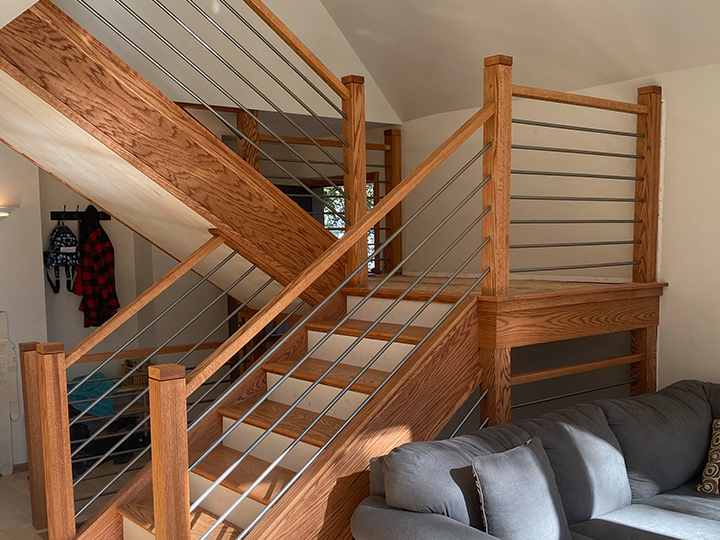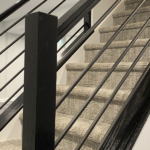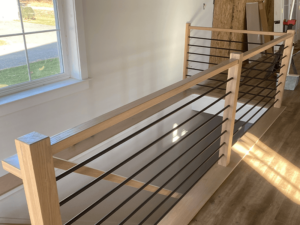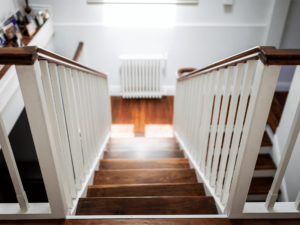
Homeowners often overlook the staircase when considering home improvements. However, this structure can significantly alter a home’s aesthetics, enhance the safety of occupants, and increase its value. The best part? The renovation does not have to be a complete overhaul. Even subtle changes can update the functionality and sustainability of the staircase, uplifting the design and feel of your living space.
Enhanced Safety
Staircase renovations start with a focus on safety, addressing issues like worn-out steps, loose handrails, and poor lighting. These updates make each step secure and easy to see, which is especially important for families with young children or people with mobility challenges.
Using modern materials can greatly improve the durability and slip resistance of a staircase, crucial for an area that’s heavily used. By selecting the right materials, homeowners can keep the staircase in good shape and prevent future wear, adding to the overall safety of the home.
As building codes evolve, older staircases might not meet current safety standards. Renovating ensures that the staircase complies with the latest regulations, protecting homeowners from potential legal issues and providing a safer environment for everyone who uses the stairs.
Adding extra safety features like extended handrails, non-slip surfaces, or gentler steps can further reduce the risk of accidents. These thoughtful design choices show that safety and style can go hand in hand, creating a staircase that is both functional and attractive.
Aesthetic Transformation
Renovating a staircase can significantly change the look of a home. Introducing new materials like glass or polished wood can add a modern or timeless touch, setting the tone for the entire home’s decor.
Choosing the right colors and materials can brighten up a previously dull area, making it feel more open and sophisticated. This not only revitalizes the staircase but also enhances the overall feel of the surrounding spaces.
Classic design features like ornate balusters and hand-carved posts can add character and charm, reflecting the homeowner’s style and adding to the home’s unique design. A well-redesigned staircase can become a standout feature, turning a functional area into a striking visual element—much like a piece of art within the home.
Increased Home Value
Renovating a staircase can boost the value of a home. Updating this key feature often results in a solid return on investment, as a modern and visually appealing staircase is attractive to potential buyers.
A well-maintained, stylish staircase can be a strong selling point. During appraisals, an updated staircase is usually valued higher, thanks to its improved safety features, modern materials, and overall design appeal.
The choice of materials and craftsmanship in a staircase remodel also significantly impacts the home’s value. Using luxury materials like hardwood, ornamental ironwork, or glass railings can create a sense of luxury and careful upkeep, which tends to attract higher offers.
More so, a staircase that matches the home’s architectural style enhances the overall aesthetic, giving the space a cohesive and thoughtfully designed feel. This harmony can make the entire home more appealing, increasing its market value.
Improved Functionality
Renovating a staircase isn’t just about looks—it can also make daily use more practical. Homeowners can customize the design to better suit their lifestyle, adding features that improve comfort and convenience.
In homes where space is limited, a renovated staircase can include smart storage options. For example, under-stair drawers or shelves can help reduce clutter by providing storage for items that would otherwise take up valuable space elsewhere.
The layout of a staircase can have a big impact on how a home feels and functions. A redesign can change the staircase’s footprint, improving access and creating a more open, inviting atmosphere.
Lighting is key to a staircase’s functionality, and a renovation offers the chance to add energy-efficient lighting. Well-placed lights not only make the staircase safer but also enhance the ambiance of the space, blending utility with aesthetic appeal.
Sustainable and Eco-Friendly Options
Opting for sustainable materials in a staircase renovation benefits both the environment and the home’s indoor air quality. Using reclaimed wood or responsibly sourced timber reduces the carbon footprint of the project while avoiding harmful chemicals often found in synthetic materials, creating a healthier living space.
Eco-conscious homeowners might choose materials like bamboo, which is strong and rapidly renewable. These choices align with green building practices, offering both durability and a smaller environmental impact, contributing to a more sustainable home.
Energy efficiency is another advantage of eco-friendly staircases, especially when LED lighting is integrated. These lights use less energy and last longer, reducing waste and the need for frequent replacements.
Meanwhile, incorporating recycled metals like aluminum or steel in handrails and balustrades can enhance both the look and sustainability of the staircase. These materials often come from sources with high recycled content, reducing the need for new raw materials and lowering the overall environmental impact of the renovation.
Invest In the Future of Your Space!
Specializing in custom stair and railing solutions, we bring your vision to life with expert craftsmanship and high-quality materials. Whether you’re looking for a modern upgrade or a timeless design, our team works closely with you to create a staircase that enhances both the beauty and functionality of your home. With Darby Stair Renovations, you’re not just renovating; you’re investing in a stylish, safe, and sustainable future for your living space.






